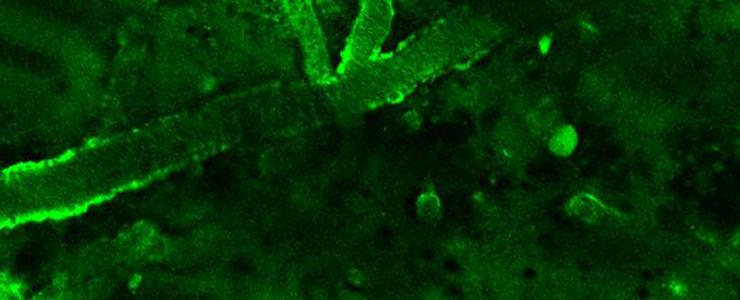The major challenge facing physicians treating Alzheimer's is the ability to detect markers of the disease as early as possible. These markers, located in the brain, are difficult to access, hampering diagnosis. Using two types of llama antibody capable of crossing the blood-brain barrier, scientists from the Institut Pasteur, Inserm, the CNRS, the CEA, Pierre & Marie Curie and Paris Descartes Universities and Roche* have developed a non-invasive approach to reach brain cells in a mouse model of the disease. Once in the brain, these llama antibodies can specifically mark and show amyloid plaques and neurofibrillary tangles, the two types of lesions that characterize Alzheimer's disease. These results were published in the Journal of Controlled Release on October 7, 2016.

The specific VHH antibody for plaques, labeled with a green fluorochrome, is injected into mice. The VHH travels along the blood vessels before marking the plaques in the brain. Photo taken using two-photon microscopy. © Institut Pasteur
Alzheimer's disease is characterized by two types of cerebral lesion: amyloid plaques and neurofibrillary tangles. Amyloid beta peptide (Aβ), naturally present in the brain, builds up over the years as a result of genetic and environmental factors until it forms amyloid plaques. This build-up is toxic for nerve cells: it leads to a loss of neuronal structure and to what is known as "neurofibrillary" tangles (abnormal aggregation of the tau protein), which in turn results in cell death.
In this study, the team led by Pierre Lafaye, Head of the Antibody Engineering Platform in the Citech[1] at the Institut Pasteur, in collaboration with the Chemistry of Biomolecules and Integrative Neurobiology of Cholinergic Systems Units from the Institut Pasteur and the CNRS, developed two new types of antibody capable of detecting the extracellular and intracellular targets (respectively amyloid plaques and neurofibrillary tangles) that are characteristic of Alzheimer's disease. To achieve this, they turned their attention to camelids, specifically llamas, since their small antibodies are easy to use. They used the variable region of the antibody, known as VHH or nanobodiesTM, to specifically recognize the markers of Alzheimer's.
These antibodies have the rare ability to cross the blood-brain barrier, which generally protects the brain from microbial attacks but also prevents potential therapeutic molecules from reaching it.
This collaborative research project, jointly conducted by scientists from the Institut Pasteur, Inserm, the CNRS, the CEA, Pierre & Marie Curie and Paris Descartes Universities and the Roche Group, led to the development of anti-Aβ and anti-tau protein antibodies that specifically detect amyloid plaques and neurofibrillary tangles. These antibodies were subsequently tested in vitro on the brain tissue of Alzheimer's patients.
The antibodies were then tested in vivo in two mouse models, each with one of the two characteristic lesions associated with Alzheimer's disease. These antibodies, labeled with a green fluorochrome, were injected intravenously and crossed the blood-brain barrier, binding to the two targets the scientists were aiming to identify: amyloid plaques and neurofibrillary tangles. This made the signs of the disease visible in the brain using two-photon microscopy. The scientists involved in this collaborative project are currently working on the development of an MRI imaging technique to observe the lesions. In the long term this could be applied to humans.
"Being able to diagnose Alzheimer's at an early stage could enable us to test treatments before the emergence of symptoms, something we were previously unable to do," explained Pierre Lafaye. These VHH antibodies could be used in combination with therapeutic molecules so that the molecules can be delivered in a targeted way to the brain.
Patents have been filed for these VHH antibodies and for their use based on their ability to cross the blood-brain barrier and bind to amyloid plaques and tau proteins.
This research was partly funded by the Roche Institute, the France Alzheimer Foundation and the Georges Pompidou Foundation.
Source
* Camelid single-domain antibodies: A versatile tool for in vivo imaging of extracellular and intracellular brain targets, Journal of Controlled Release, October 7, 2016
Tengfei Li (a,b,c,d,e,f,1), Matthias Vandesquille (g,h,i,j,1), Fani Koukouli (k), Clémence Dudeffant (b,c,d,e,i,j), Ihsen Youssef (b,c,d,e), Pascal Lenormand (a), Christelle Ganneau (g,h), Uwe Maskos (k), Christian Czech (l), Fiona Grueninger (l,) Charles Duyckaerts (b,c,d,e), Marc Dhenain (i,j), Sylvie Bay (g,h), Benoît Delatour (b,c,d,e), Pierre Lafaye (a*)
(a) Institut Pasteur, CITECH, Plateforme d'Ingénierie des Anticorps, 75724 Paris Cedex 15, France
(b) Sorbonne Universités, UPMC Univ. Paris 06 UMR S 1127, F-75013 Paris, France
(c) Inserm U 1127, Paris, France
(d) CNRS UMR 7225, Paris, France
(e) ICM, Paris, France
(f) Université Paris Descartes, Paris 5, France
(g) Institut Pasteur, Unité de Chimie des Biomolécules, 75724 Paris Cedex 15, France
(h) CNRS UMR 3523, 75724 Paris Cedex 15, France
(i) Commissariat à l'Energie Atomique et aux Energies Alternatives (CEA), Direction de la Recherche Fondamentale (DRF), Institut d'Imagerie Biomédicale (I2BM), MIRCen, F-92260 Fontenay-aux-Roses, France
(j) Centre National de la Recherche Scientifique (CNRS), Université Paris-Sud, Université Paris-Saclay UMR 9199, Neurodegenerative Diseases Laboratory, F-92260 Fontenay-aux-Roses, France
(k) Institut Pasteur, Neurobiologie intégrative des systèmes cholinergiques, CNRS UMR 3571, Paris, France
(l) F. Hoffmann-La Roche AG, Pharmaceutical Research and Early Development, NORD DTA, Roche Innovation Center Basel, CH-4070 Basel, Switzerland





